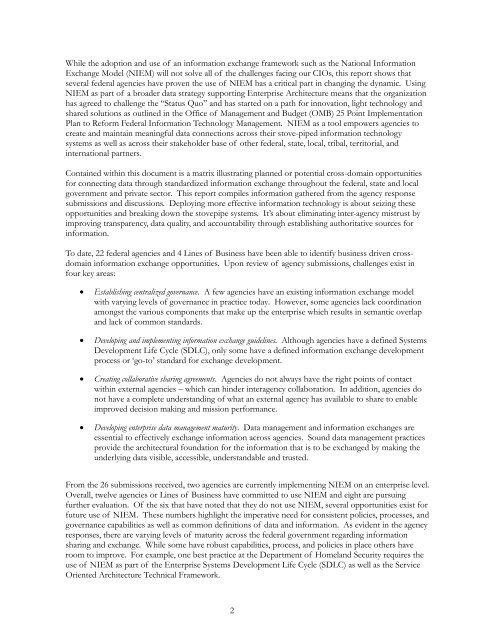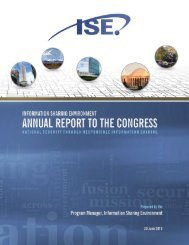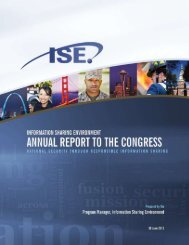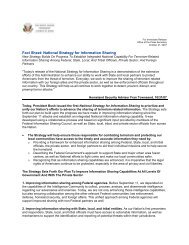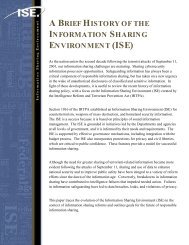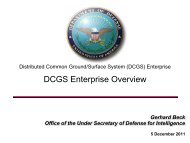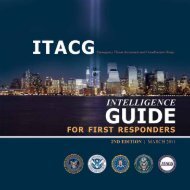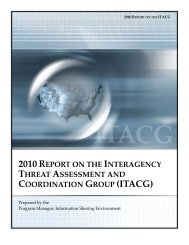agency information exchange functional standards evaluation
agency information exchange functional standards evaluation
agency information exchange functional standards evaluation
Create successful ePaper yourself
Turn your PDF publications into a flip-book with our unique Google optimized e-Paper software.
While the adoption and use of an <strong>information</strong> <strong>exchange</strong> framework such as the National Information<br />
Exchange Model (NIEM) will not solve all of the challenges facing our CIOs, this report shows that<br />
several federal agencies have proven the use of NIEM has a critical part in changing the dynamic. Using<br />
NIEM as part of a broader data strategy supporting Enterprise Architecture means that the organization<br />
has agreed to challenge the “Status Quo” and has started on a path for innovation, light technology and<br />
shared solutions as outlined in the Office of Management and Budget (OMB) 25 Point Implementation<br />
Plan to Reform Federal Information Technology Management. NIEM as a tool empowers agencies to<br />
create and maintain meaningful data connections across their stove-piped <strong>information</strong> technology<br />
systems as well as across their stakeholder base of other federal, state, local, tribal, territorial, and<br />
international partners.<br />
Contained within this document is a matrix illustrating planned or potential cross-domain opportunities<br />
for connecting data through standardized <strong>information</strong> <strong>exchange</strong> throughout the federal, state and local<br />
government and private sector. This report compiles <strong>information</strong> gathered from the <strong>agency</strong> response<br />
submissions and discussions. Deploying more effective <strong>information</strong> technology is about seizing these<br />
opportunities and breaking down the stovepipe systems. It’s about eliminating inter-<strong>agency</strong> mistrust by<br />
improving transparency, data quality, and accountability through establishing authoritative sources for<br />
<strong>information</strong>.<br />
To date, 22 federal agencies and 4 Lines of Business have been able to identify business driven crossdomain<br />
<strong>information</strong> <strong>exchange</strong> opportunities. Upon review of <strong>agency</strong> submissions, challenges exist in<br />
four key areas:<br />
• Establishing centralized governance. A few agencies have an existing <strong>information</strong> <strong>exchange</strong> model<br />
with varying levels of governance in practice today. However, some agencies lack coordination<br />
amongst the various components that make up the enterprise which results in semantic overlap<br />
and lack of common <strong>standards</strong>.<br />
• Developing and implementing <strong>information</strong> <strong>exchange</strong> guidelines. Although agencies have a defined Systems<br />
Development Life Cycle (SDLC), only some have a defined <strong>information</strong> <strong>exchange</strong> development<br />
process or ‘go-to’ standard for <strong>exchange</strong> development.<br />
• Creating collaborative sharing agreements. Agencies do not always have the right points of contact<br />
within external agencies – which can hinder inter<strong>agency</strong> collaboration. In addition, agencies do<br />
not have a complete understanding of what an external <strong>agency</strong> has available to share to enable<br />
improved decision making and mission performance.<br />
• Developing enterprise data management maturity. Data management and <strong>information</strong> <strong>exchange</strong>s are<br />
essential to effectively <strong>exchange</strong> <strong>information</strong> across agencies. Sound data management practices<br />
provide the architectural foundation for the <strong>information</strong> that is to be <strong>exchange</strong>d by making the<br />
underlying data visible, accessible, understandable and trusted.<br />
From the 26 submissions received, two agencies are currently implementing NIEM on an enterprise level.<br />
Overall, twelve agencies or Lines of Business have committed to use NIEM and eight are pursuing<br />
further <strong>evaluation</strong>. Of the six that have noted that they do not use NIEM, several opportunities exist for<br />
future use of NIEM. These numbers highlight the imperative need for consistent policies, processes, and<br />
governance capabilities as well as common definitions of data and <strong>information</strong>. As evident in the <strong>agency</strong><br />
responses, there are varying levels of maturity across the federal government regarding <strong>information</strong><br />
sharing and <strong>exchange</strong>. While some have robust capabilities, process, and policies in place others have<br />
room to improve. For example, one best practice at the Department of Homeland Security requires the<br />
use of NIEM as part of the Enterprise Systems Development Life Cycle (SDLC) as well as the Service<br />
Oriented Architecture Technical Framework.<br />
2


